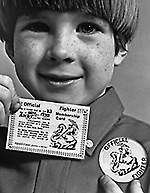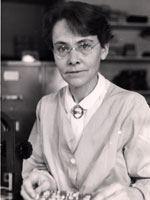1. What characters have political cartoonists used to represent the English counterparts to Uncle Sam and Lady Liberty?
c. John Bull and Britannia.
 Wearing breeches and a Union Jack waistcoat, John Bull once served as the symbol for the British everyman, but evolved into a symbol of the country as a whole. Both Britannia, the goddess-like female figure of England, and John Bull often appeared in political cartoons with Uncle Sam or Columbia—another name for Lady Liberty.
Wearing breeches and a Union Jack waistcoat, John Bull once served as the symbol for the British everyman, but evolved into a symbol of the country as a whole. Both Britannia, the goddess-like female figure of England, and John Bull often appeared in political cartoons with Uncle Sam or Columbia—another name for Lady Liberty.
2. This version of Uncle Sam appeared in a Denver Evening Post cartoon in November 1898. Uncle Sam is usually drawn as a skinny character. Why is he fat here?
b. He has just finished consuming overseas territories, such as Hawaii, Puerto Rico and the Philippines.
 In a spree of imperialism, the United States, represented by Uncle Sam, has "consumed" Hawaii (annexed to the U.S. on July, 1898), as well as Puerto Rico and the Philippines (though the Treaty of Paris and the acquisition of these as territories was still in debate in November 1898). Now, Uncle Sam turns to the figure of Spain—the cartoon's caption has him say, "Now, young man, I'll attend to your case." With the Spanish-American War over, the glutted U.S. prepares to attend to Spain itself, not just its colonies.
In a spree of imperialism, the United States, represented by Uncle Sam, has "consumed" Hawaii (annexed to the U.S. on July, 1898), as well as Puerto Rico and the Philippines (though the Treaty of Paris and the acquisition of these as territories was still in debate in November 1898). Now, Uncle Sam turns to the figure of Spain—the cartoon's caption has him say, "Now, young man, I'll attend to your case." With the Spanish-American War over, the glutted U.S. prepares to attend to Spain itself, not just its colonies.
3. When did political cartoonists draw Uncle Sam as a self-appointed global policeman?
d. During the "Imperialist" phase of U.S. foreign affairs, beginning prior to the Spanish-American War.
 In the years leading up to the Spanish-American War and the U.S. metamorphosis into an imperialist world power, Uncle Sam was often drawn as a police officer. However, cartoonist Thomas Nast had already pictured Uncle Sam as a cop on the beat, policing U.S. political corruption, as early as 1888.
In the years leading up to the Spanish-American War and the U.S. metamorphosis into an imperialist world power, Uncle Sam was often drawn as a police officer. However, cartoonist Thomas Nast had already pictured Uncle Sam as a cop on the beat, policing U.S. political corruption, as early as 1888.
4. When Uncle Sam first appeared, he was drawn to resemble:
a. An old gentleman in knee breeches.
 For several decades, Uncle Sam was indistinguishable from an earlier character, Brother Jonathan, who also represented the U.S., superceding Yankee Doodle. By the middle of the 19th century, the same figure-by then clad in striped pants, short jacket, and top hat—was sometimes called Uncle Sam and sometimes Brother Jonathan. By about 1875, "Brother Jonathan" had mostly disappeared.
For several decades, Uncle Sam was indistinguishable from an earlier character, Brother Jonathan, who also represented the U.S., superceding Yankee Doodle. By the middle of the 19th century, the same figure-by then clad in striped pants, short jacket, and top hat—was sometimes called Uncle Sam and sometimes Brother Jonathan. By about 1875, "Brother Jonathan" had mostly disappeared.
5. When Columbia first appeared, she most closely resembled:
a. The goddess of liberty, Libertas.
 Often depicted in the French Revolution, Libertas wore a soft "liberty" or "Phrygian" cap. As Columbia, she could also wear feathers on her head, a reference to Native Americans, or a star or crown. The name "Columbia" fell out of popularity after World War I, and the character gained the names "Miss Liberty" or "Lady Liberty."
Often depicted in the French Revolution, Libertas wore a soft "liberty" or "Phrygian" cap. As Columbia, she could also wear feathers on her head, a reference to Native Americans, or a star or crown. The name "Columbia" fell out of popularity after World War I, and the character gained the names "Miss Liberty" or "Lady Liberty."
 From the late 1880s to around 1940, Yiddish-language theatre found a home in New York City—as did the wave of Jewish immigrants who brought the performance form to the U.S. Fleeing persecution in Russia, these immigrants, whether they chose to be performing artists or audience members, developed a unique theatre culture. Unlike the short variety acts of contemporary vaudeville, Yiddish theatre presented full-evening-length plays, accompanied by music or broken up with song-and-dance numbers. Plays adapted popular works by authors like Shakespeare and Anton Chekhov, drew from folklore and folk customs, and/or commented on recent events in the U.S. and abroad. Some addressed issues of assimilation, such as intermarriage and generational gaps, while others praised the virtues of the immigrants' adopted country—as did the musicals mentioned above.
From the late 1880s to around 1940, Yiddish-language theatre found a home in New York City—as did the wave of Jewish immigrants who brought the performance form to the U.S. Fleeing persecution in Russia, these immigrants, whether they chose to be performing artists or audience members, developed a unique theatre culture. Unlike the short variety acts of contemporary vaudeville, Yiddish theatre presented full-evening-length plays, accompanied by music or broken up with song-and-dance numbers. Plays adapted popular works by authors like Shakespeare and Anton Chekhov, drew from folklore and folk customs, and/or commented on recent events in the U.S. and abroad. Some addressed issues of assimilation, such as intermarriage and generational gaps, while others praised the virtues of the immigrants' adopted country—as did the musicals mentioned above. In 1852, the Tong Hook Tong Dramatic Company arrived in California, following the stream of Chinese immigrants who had come to the state with the 1848 gold rush. Greeted warmly by immigrant audiences, they accepted a contract to perform in New York City. In New York, they discovered the contract was a scam, and secured their own theatre space, performing for New Yorkers independently. Chinese opera bears little resemblance to European opera, and even less to the "Oriental" image of China then popular on the mainstream stage. Confused by what they were seeing, New Yorkers rejected genuine Chinese theatre that did not match up with contemporary media stereotypes.
In 1852, the Tong Hook Tong Dramatic Company arrived in California, following the stream of Chinese immigrants who had come to the state with the 1848 gold rush. Greeted warmly by immigrant audiences, they accepted a contract to perform in New York City. In New York, they discovered the contract was a scam, and secured their own theatre space, performing for New Yorkers independently. Chinese opera bears little resemblance to European opera, and even less to the "Oriental" image of China then popular on the mainstream stage. Confused by what they were seeing, New Yorkers rejected genuine Chinese theatre that did not match up with contemporary media stereotypes. In 1965, Luis Valdez, the son of Chicano migrant farm workers, founded the theatrical company El Teatro Campesino. El Teatro Campesino took theatrical performances—often without props, sets, or written scripts—directly to the camps of migrant farm workers. In its performances, the company sought to inspire farm workers to form a farm workers' union, but it also performed pieces based on Mexican popular theatre: corridas (dramatized ballads), peladitos (comic skits with an underdog protagonist), and religious pageants.
In 1965, Luis Valdez, the son of Chicano migrant farm workers, founded the theatrical company El Teatro Campesino. El Teatro Campesino took theatrical performances—often without props, sets, or written scripts—directly to the camps of migrant farm workers. In its performances, the company sought to inspire farm workers to form a farm workers' union, but it also performed pieces based on Mexican popular theatre: corridas (dramatized ballads), peladitos (comic skits with an underdog protagonist), and religious pageants. Prior to the Great Migration of the early 20th century, when African Americans came north in search of a better life, major record companies released African American music, but only as performed by white performers. Sensing the potential for a new market, the companies began to record African American performers and release their music on special labels targeted at African American audiences. Called "race records," these records were later marketed to white audiences as well. African Americans also established their own companies to distribute records—the first African American owned label, Black Swan, was established in 1921. Many styles of music associated with race records would later be recategorized as "rhythm and blues."
Prior to the Great Migration of the early 20th century, when African Americans came north in search of a better life, major record companies released African American music, but only as performed by white performers. Sensing the potential for a new market, the companies began to record African American performers and release their music on special labels targeted at African American audiences. Called "race records," these records were later marketed to white audiences as well. African Americans also established their own companies to distribute records—the first African American owned label, Black Swan, was established in 1921. Many styles of music associated with race records would later be recategorized as "rhythm and blues."
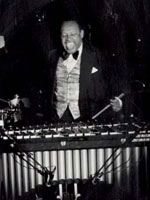
 False. Advertising executive Rosser Reeves had previously created the "melts in your mouth, not in your hands" campaign for M&Ms. The campaign he planned for Eisenhower—20-second spots designed to run before or after popular television shows like I Love Lucy—featured "normal Joe" citizens asking Eisenhower questions about taxes, foreign policy, and other issues. Eisenhower answered in a brief, blunt, homey fashion, with the format giving the campaign its name: "Eisenhower Answers America." Prior to this campaign, presidential candidates had brushed off the potential of television advertising; following it, ads became an accepted and increasingly central aspect of campaigning.
False. Advertising executive Rosser Reeves had previously created the "melts in your mouth, not in your hands" campaign for M&Ms. The campaign he planned for Eisenhower—20-second spots designed to run before or after popular television shows like I Love Lucy—featured "normal Joe" citizens asking Eisenhower questions about taxes, foreign policy, and other issues. Eisenhower answered in a brief, blunt, homey fashion, with the format giving the campaign its name: "Eisenhower Answers America." Prior to this campaign, presidential candidates had brushed off the potential of television advertising; following it, ads became an accepted and increasingly central aspect of campaigning. True. JFK's 1960 campaign for the presidency, run by two different advertising agencies, included a multitude of television advertisements and a dizzying array of techniques and appeals. Several of the ads spoke out to specific demographics—including a spot in which Jackie Kennedy, speaking in uneven Spanish, assured voters that, in the face of the danger of communism, "Mi esposo siempre vigilará los intereses de todos los sectores de nuestra sociedad que necesitan la protección de un gobierno humanitario" (or, "My husband will always watch over the interests of all sectors of our society who are in need of the protection of a humanitarian government"). Other ads spoke to the African American community, assuring the public that Kennedy's Catholicism would not compromise his presidential duties.
True. JFK's 1960 campaign for the presidency, run by two different advertising agencies, included a multitude of television advertisements and a dizzying array of techniques and appeals. Several of the ads spoke out to specific demographics—including a spot in which Jackie Kennedy, speaking in uneven Spanish, assured voters that, in the face of the danger of communism, "Mi esposo siempre vigilará los intereses de todos los sectores de nuestra sociedad que necesitan la protección de un gobierno humanitario" (or, "My husband will always watch over the interests of all sectors of our society who are in need of the protection of a humanitarian government"). Other ads spoke to the African American community, assuring the public that Kennedy's Catholicism would not compromise his presidential duties.  False. Nixon's 1972 campaign for reelection cast him as a man of "compassion, courage, and conscience," concerned about many issues, including environmentalism and international diplomacy, as well as withdrawing from Vietnam. President Nixon, one ad declared, was willing to press for change, because "without change there can be no progress." The ads crafted the argument that Nixon, far from being cold and unapproachable, was personable and personally interested in a global push for peace and wellbeing nationally and internationally. Nixon won the campaign against South Dakota Senator George McGovern by a landslide.
False. Nixon's 1972 campaign for reelection cast him as a man of "compassion, courage, and conscience," concerned about many issues, including environmentalism and international diplomacy, as well as withdrawing from Vietnam. President Nixon, one ad declared, was willing to press for change, because "without change there can be no progress." The ads crafted the argument that Nixon, far from being cold and unapproachable, was personable and personally interested in a global push for peace and wellbeing nationally and internationally. Nixon won the campaign against South Dakota Senator George McGovern by a landslide. False. Though most of Ronald Reagan's ads stressed the economic wellbeing of the U.S., using montages of small-town Americans engaged in rituals such as weddings and buying new homes, one stuck out. The unusual ad showed a bear lurking in the woods; the accompanying narration suggested that the bear might or might not exist and might or might not be dangerous, but "since no one can really be sure who's right, isn't it smart to be as strong as the bear? If there is a bear?" Though the ad never explicitly states what the bear stands for, the advertisement's creators intended it to symbolize the Soviet Union. The ad's watchers, however, took it as commenting on any number of issues, including gun control and the need for change in environmental laws. Despite its ambiguity, the ad gained attention and later served as inspiration for an ad in George W. Bush's 2004 reelection campaign.
False. Though most of Ronald Reagan's ads stressed the economic wellbeing of the U.S., using montages of small-town Americans engaged in rituals such as weddings and buying new homes, one stuck out. The unusual ad showed a bear lurking in the woods; the accompanying narration suggested that the bear might or might not exist and might or might not be dangerous, but "since no one can really be sure who's right, isn't it smart to be as strong as the bear? If there is a bear?" Though the ad never explicitly states what the bear stands for, the advertisement's creators intended it to symbolize the Soviet Union. The ad's watchers, however, took it as commenting on any number of issues, including gun control and the need for change in environmental laws. Despite its ambiguity, the ad gained attention and later served as inspiration for an ad in George W. Bush's 2004 reelection campaign. To watch all of the ads mentioned in this quiz, check out the Museum of the Moving Image's website
To watch all of the ads mentioned in this quiz, check out the Museum of the Moving Image's website 
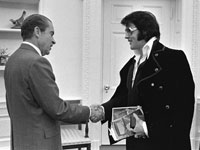
 Wearing breeches and a Union Jack waistcoat, John Bull once served as the symbol for the British everyman, but evolved into a symbol of the country as a whole. Both Britannia, the goddess-like female figure of England, and John Bull often appeared in political cartoons with Uncle Sam or Columbia—another name for Lady Liberty.
Wearing breeches and a Union Jack waistcoat, John Bull once served as the symbol for the British everyman, but evolved into a symbol of the country as a whole. Both Britannia, the goddess-like female figure of England, and John Bull often appeared in political cartoons with Uncle Sam or Columbia—another name for Lady Liberty.  In a spree of imperialism, the United States, represented by Uncle Sam, has "consumed" Hawaii (annexed to the U.S. on July, 1898), as well as Puerto Rico and the Philippines (though the Treaty of Paris and the acquisition of these as territories was still in debate in November 1898). Now, Uncle Sam turns to the figure of Spain—the cartoon's caption has him say, "Now, young man, I'll attend to your case." With the Spanish-American War over, the glutted U.S. prepares to attend to Spain itself, not just its colonies.
In a spree of imperialism, the United States, represented by Uncle Sam, has "consumed" Hawaii (annexed to the U.S. on July, 1898), as well as Puerto Rico and the Philippines (though the Treaty of Paris and the acquisition of these as territories was still in debate in November 1898). Now, Uncle Sam turns to the figure of Spain—the cartoon's caption has him say, "Now, young man, I'll attend to your case." With the Spanish-American War over, the glutted U.S. prepares to attend to Spain itself, not just its colonies. In the years leading up to the Spanish-American War and the U.S. metamorphosis into an imperialist world power, Uncle Sam was often drawn as a police officer. However, cartoonist Thomas Nast had already pictured Uncle Sam as a cop on the beat, policing U.S. political corruption, as early as 1888.
In the years leading up to the Spanish-American War and the U.S. metamorphosis into an imperialist world power, Uncle Sam was often drawn as a police officer. However, cartoonist Thomas Nast had already pictured Uncle Sam as a cop on the beat, policing U.S. political corruption, as early as 1888. For several decades, Uncle Sam was indistinguishable from an earlier character, Brother Jonathan, who also represented the U.S., superceding Yankee Doodle. By the middle of the 19th century, the same figure-by then clad in striped pants, short jacket, and top hat—was sometimes called Uncle Sam and sometimes Brother Jonathan. By about 1875, "Brother Jonathan" had mostly disappeared.
For several decades, Uncle Sam was indistinguishable from an earlier character, Brother Jonathan, who also represented the U.S., superceding Yankee Doodle. By the middle of the 19th century, the same figure-by then clad in striped pants, short jacket, and top hat—was sometimes called Uncle Sam and sometimes Brother Jonathan. By about 1875, "Brother Jonathan" had mostly disappeared. Often depicted in the French Revolution, Libertas wore a soft "liberty" or "Phrygian" cap. As Columbia, she could also wear feathers on her head, a reference to Native Americans, or a star or crown. The name "Columbia" fell out of popularity after World War I, and the character gained the names "Miss Liberty" or "Lady Liberty."
Often depicted in the French Revolution, Libertas wore a soft "liberty" or "Phrygian" cap. As Columbia, she could also wear feathers on her head, a reference to Native Americans, or a star or crown. The name "Columbia" fell out of popularity after World War I, and the character gained the names "Miss Liberty" or "Lady Liberty."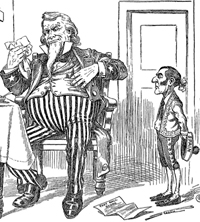




 Oysters became a high-demand source of protein and nutrition following the Civil War. With the rise of industry and of shipping by rail, canneries and corporate oyster farming operations sprang up on both coasts, eager to supply the working class, and anyone else who wanted the tasty shellfish, with oysters shipped live or canned. In San Francisco, a center of oyster piracy, the boom years of the oyster industry corresponded, unsurprisingly, with those of the oyster industry—both took off in 1870, as the state began allowing major oyster farming operations to purchase the rights to underwater bay "land" (traditionally common property), and petered off in the 1920s, as silt and pollution disrupted the bay's ecosystem.
Oysters became a high-demand source of protein and nutrition following the Civil War. With the rise of industry and of shipping by rail, canneries and corporate oyster farming operations sprang up on both coasts, eager to supply the working class, and anyone else who wanted the tasty shellfish, with oysters shipped live or canned. In San Francisco, a center of oyster piracy, the boom years of the oyster industry corresponded, unsurprisingly, with those of the oyster industry—both took off in 1870, as the state began allowing major oyster farming operations to purchase the rights to underwater bay "land" (traditionally common property), and petered off in the 1920s, as silt and pollution disrupted the bay's ecosystem. At 15, Jack London bought a boat, the Razzle Dazzle, and joined the oyster pirates of San Francisco Bay to escape work as a child laborer. London wrote about his experiences in his semi-fictional autobiography, John Barleycorn, and used them in his early work, The Cruise of the Dazzler, and in his Tales of the Fish Patrol. The latter tells the story of oyster pirates from law enforcement's perspective—after sailing as an oyster pirate, London switched sides himself, to hunt his former compatriots.
At 15, Jack London bought a boat, the Razzle Dazzle, and joined the oyster pirates of San Francisco Bay to escape work as a child laborer. London wrote about his experiences in his semi-fictional autobiography, John Barleycorn, and used them in his early work, The Cruise of the Dazzler, and in his Tales of the Fish Patrol. The latter tells the story of oyster pirates from law enforcement's perspective—after sailing as an oyster pirate, London switched sides himself, to hunt his former compatriots. The working class romanticized oyster pirates as Robin-Hood-like heroes, fighting back against the new big businesses' private control of what had once been common land. Traditionally, underwater "real estate" was commonly owned—anyone with a boat or oyster tongs could fish or dredge without fear of trespassing. Following the Civil War, states began leasing maritime "land" out to private owners; and the public protested, by engaging in oyster piracy, supporting oyster pirates, scavenging in tidal flats and along the boundaries of maritime property, and, occasionally, engaging in armed uprisings.
The working class romanticized oyster pirates as Robin-Hood-like heroes, fighting back against the new big businesses' private control of what had once been common land. Traditionally, underwater "real estate" was commonly owned—anyone with a boat or oyster tongs could fish or dredge without fear of trespassing. Following the Civil War, states began leasing maritime "land" out to private owners; and the public protested, by engaging in oyster piracy, supporting oyster pirates, scavenging in tidal flats and along the boundaries of maritime property, and, occasionally, engaging in armed uprisings.  The opera satirized Governor William Evelyn Cameron's second raid against oyster pirates in the Chesapeake Bay, on February 27, 1883. Cameron had conducted a very successful raid the previous February, capturing seven boats and 46 dredgers, later pardoning most of them to appease public opinion—which saw the pirates as remorseful, hard-working family men. His second raid, in 1883, went poorly. Almost all of the ships he and his crews chased escaped into Maryland waters, including the Dancing Molly, a sloop manned only by its captain's wife and two daughters (the men had been ashore when the governor started pursuit). The public hailed the pirates as heroes and ridiculed the governor in the popular media—the Lynchberg Advance, for instance, ran a
The opera satirized Governor William Evelyn Cameron's second raid against oyster pirates in the Chesapeake Bay, on February 27, 1883. Cameron had conducted a very successful raid the previous February, capturing seven boats and 46 dredgers, later pardoning most of them to appease public opinion—which saw the pirates as remorseful, hard-working family men. His second raid, in 1883, went poorly. Almost all of the ships he and his crews chased escaped into Maryland waters, including the Dancing Molly, a sloop manned only by its captain's wife and two daughters (the men had been ashore when the governor started pursuit). The public hailed the pirates as heroes and ridiculed the governor in the popular media—the Lynchberg Advance, for instance, ran a  Oyster piracy highlights the class tensions that sprang up during post-Civil War industrialization. Big business and private ownership began to drive the economy, shaping the lives of the working class and changing long-established institutions and daily patterns. Young people such as Jack London turned to oyster piracy as an escape from the new factory work—and the working class chaffed against the loss of traditional maritime common lands to business owners.
Oyster piracy highlights the class tensions that sprang up during post-Civil War industrialization. Big business and private ownership began to drive the economy, shaping the lives of the working class and changing long-established institutions and daily patterns. Young people such as Jack London turned to oyster piracy as an escape from the new factory work—and the working class chaffed against the loss of traditional maritime common lands to business owners.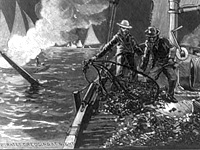

 Rubella
Rubella Diphtheria
Diphtheria  Smallpox
Smallpox  Polio
Polio The Centers for Disease Control and Prevention website provides resources on (largely present-day) health and health practices, but its
The Centers for Disease Control and Prevention website provides resources on (largely present-day) health and health practices, but its 